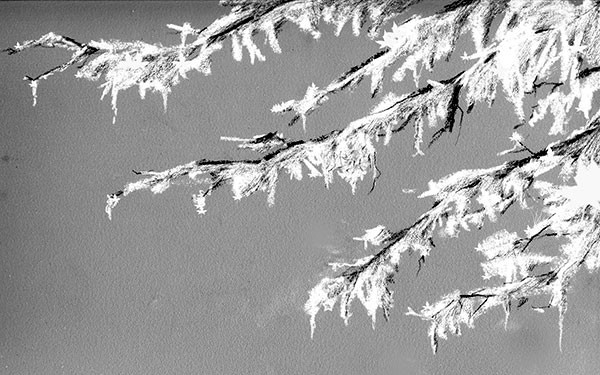
Ice storm.
If you live in northern New England, those words can send a chill up your spine. They portend demolition derbies on the roads, power outages and the ominous cracking sound of limbs breaking and trees falling in woods, parks and urban streets.
Snow we’re up for. Ice, not so much.
But ice storms have been a fact of life in this part of North America for millennia. In fact, they helped shape our forests. “It’s just one of the disturbances that helped determine what tree species are successful in one place rather than another,” said Kevin Smith, a plant physiologist with the U.S. Forest Service who has studied ice storm and other damage to trees for much of the last three decades.
Ice storms happen when merging warm and cold air masses create a layer cake in the atmosphere. Precipitation in the topmost cold layer falls into warm air and melts. When it hits a lower cold layer it supercools. This “freezing rain” turns to ice when it hits cold things near the ground.
The mother of all ice storms occurred in January of 1998. Millions of people in the Northeast and Canada were without power and millions of trees were damaged.
Ice is heavy, and an ice storm can shroud a tree in hundreds of pounds of the stuff.
Trees vary in how well they handle ice. Broadly speaking, conifers do better than hardwoods. Spruces, with their downward sloping branches, don’t even seem to notice. The branches of white pines droop under the weight; too much and they snap. Ashes are “real champs” at dealing with ice storms, in Smith’s words. Sugar maples and oaks handle ice pretty well. Birches, with their finely branching crowns, tend to lose a lot of their crowns and, in many cases, end up bent almost double.
In the wake of the 1998 storm, Smith and two colleagues began a long-term study of how ice storm-damaged trees fared. They tagged 584 trees of six species in six locations in Vermont, New Hampshire and Maine. Each was rated for damage based on how much crown it had lost: less than half; half to three quarters; or more than half.
When they looked at the trees again five years later, they found that, amazingly, better than 90 percent of most species were alive. The exception was white birch, which was dying because of root rot disease that infected the trees before the storm.
In late 2012, the researchers checked on their study subjects again (minus those trees that had been logged in the interim) and found 90 to 100 percent survival of the least-damaged trees of all species except white birch.
In a recently published U.S. Forest Service paper, Smith and plant pathologist Walter Shortle stated that 84 percent of the tagged trees were alive after 15 years; and 90 to 100 percent of the least damaged maple and ash survived. Trees that lost more than half their crown died at a rate five times those that lost less than half.
Crown injury reduces the number of leaves and thus the amount of energy a tree collects; energy it needs to recover. Branch breakage creates open wounds that allow in disease and insects. An injured tree’s prognosis is directly related to how quickly it can replace its crown and how good it is at walling off damaged areas.
“What I found most interesting is how resilient individual trees are, particularly ash and beech. Some individual trees lost almost all of their crown and within three to five years developed a new one. That’s something I wasn’t expecting to see,” Smith said.
Interestingly, Smith and his colleagues found that the ice storm mortality corresponded closely to the natural drop in the number of trees per acre that you would expect to see as a forest ages and trees get bigger in size but fewer in number, a trend predicted by stocking charts foresters use.
Of course, if your favorite shade tree is broken, your sugarbush devastated or your lovingly-maintained woodlot pounded by an ice storm, that’s poor consolation.
“I have a lot of sympathy for people who get hit hard and have an economic loss from ice storms. It does happen,” said Smith. “But in the bigger picture this is a natural part of the ecology. It’s life and death in the forest. This is how it plays out.”


Discussion *